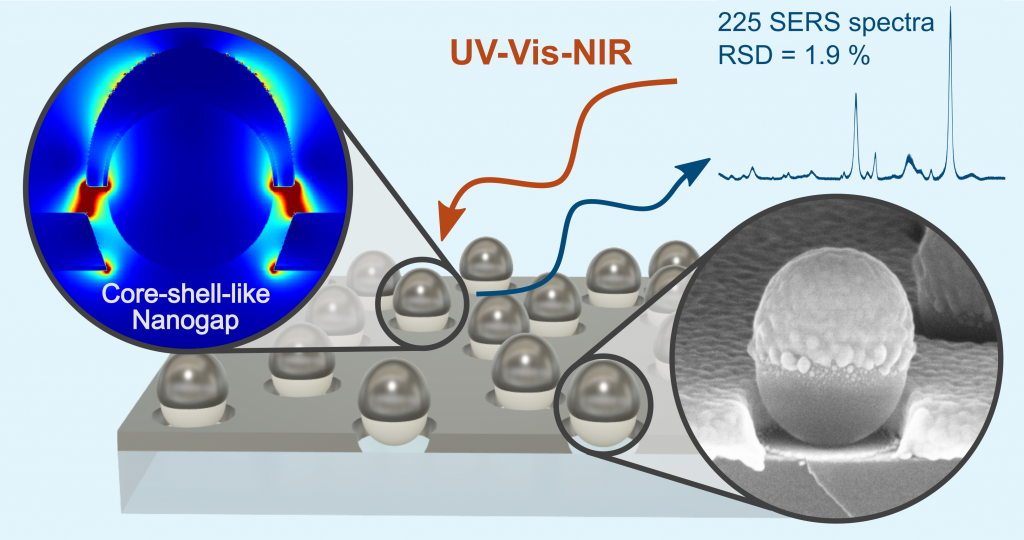Article in ACS Applied Materials & Interfaces (2025)
22 04 2025
Plasmonic nanostructures in SERS spectroscopy
The development of chemical and biological analytics, and medical diagnostics is strongly dependent on the availability of novel sensors that offer competitive measurement parameters. Plasmonic nanostructures are nanometer-sized systems capable of exciting plasmons – collective vibrations of conduction electrons – when exposed to light, leading to a strong local enhancement of the electromagnetic field. Their ability to control light on the nanometer scale opens up numerous opportunities in the design of advanced photonic devices and high-sensitivity optical sensors.
These systems are particularly valuable in surface-enhanced Raman spectroscopy (SERS), which enables quantitative detection of chemical species with molecular identification, even at the single-molecule level. Efforts to improve SERS detection using plasmonic substrates typically focus on improving selected parameters, such as sensitivity, homogeneity or signal stability.
Unique core–shell-like geometry with controlled nanogap
Researchers from the Faculty of Chemistry at the University of Warsaw (M.Sc. Aleksandra Szymańska and Dr Agata Królikowska), in collaboration with scientists from the Faculty of Physics, University of Warsaw (M.Sc. Mihai C. Suster, Dr Hab. Tomasz Antosiewicz, and Dr Piotr Wróbel), have designed, fabricated, and then characterized and optimized novel plasmonic substrates for versatile SERS analysis. The developed simple method based on nanosphere lithography allows to fabricate amorphous arrays of nanostructures with core–shell-like geometry over an area larger than 6 cm², with a nanogap size precisely controlled by adjusting the parameters of the fabrication process. These nanostructures exhibit tunable three-mode plasmonic response across a wide spectral range and concentrate light in gaps smaller than 10 nm, which are accessible and in direct contact with the surrounding environment – a critical factor for molecular analysis.
Understanding the optical properties of the substrates through numerical simulations and optimization of the synthesis parameters (metal layer thickness, size, and concentration of the nanospheres) enabled high nanoscale enhancement of the electric field, control over the spectral position of plasmonic resonances in the Vis-NIR range, and high uniformity of the optical response, thus enabling the creation of a nanoarchitecture suitable for comprehensive SERS analysis.
The resulting geometry and control over the fabrication protocol provided substrates with simultaneously high sensitivity, outstanding spatial homogeneity, very good batch-to-batch reproducibility, high signal stability, and effective performance for three different types of model analytes in SERS spectroscopy. All five rigorous criteria for high-quality SERS substrates (according to literature standards) were satisfied, which is rare.
What next?
Due to the versatility of tuning and the broad range of optical response (UV-Vis-NIR), the developed substrates represent a universal plasmonic platform that could become the core of future analytical, biomedical, and optical devices. Their simplicity in fabrication and high efficiency performance make them a candidate for breakthrough technology, providing tailored material properties for specific applications.
Publication:
Nanogap-Engineered Core−Shell-Like Nanostructures for Comprehensive SERS Analysis
M. C. Suster, A. Szymańska, T. J. Antosiewicz, A. Królikowska*, P. Wróbel*
ACS Applied Materials & Interfaces., 2025, ASAP Article,
DOI: 10.1021/acsami.5c00716
https://pubs.acs.org/doi/10.1021/acsami.5c00716

